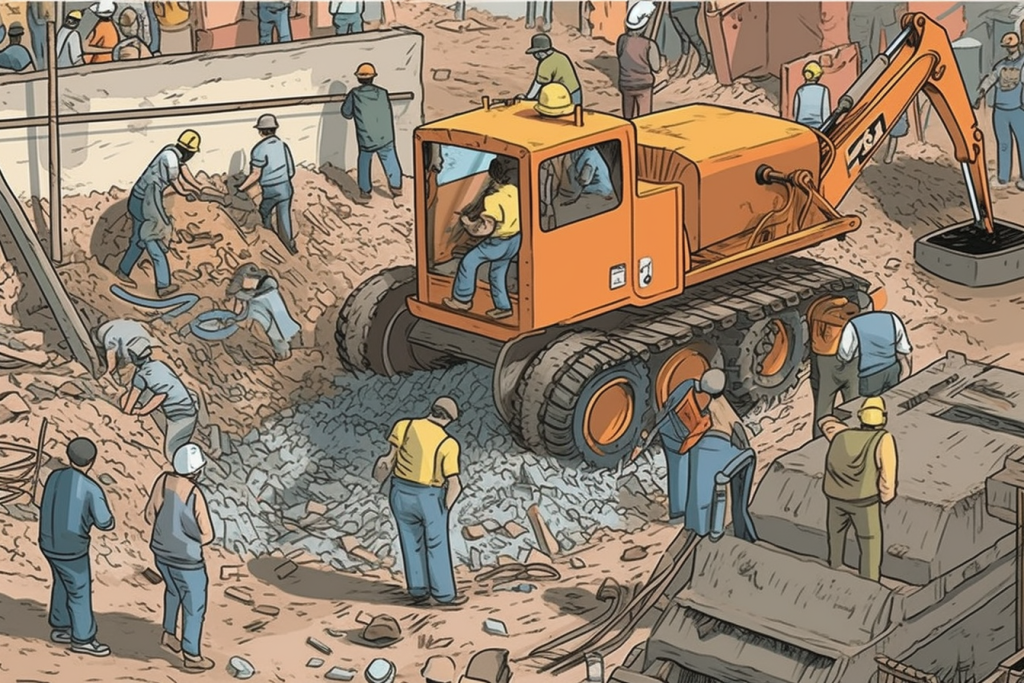Construction Safety: How to Resolve Construction On-Site Issues and Emergencies for Superintendents
Table of Contents:
Construction projects are complex and often unpredictable. From changing weather conditions to unexpected design changes, there are countless variables that can impact the success of a construction project. As a result, issues and emergencies are not uncommon on construction sites. These can range from minor setbacks to major safety hazards and can cause significant delays and cost overruns if not resolved quickly.

Superintendents play a critical role in managing construction sites and ensuring that projects are completed on time, within budget, and to the required quality standards. They are responsible for overseeing all aspects of the construction process, from planning and design to execution and delivery. This involves coordinating with architects, engineers, contractors, and other stakeholders to ensure that everyone is working together towards a common goal.
However, even with the most meticulous planning, issues and emergencies can still occur on construction sites. When they do, superintendents must be prepared to act quickly and effectively to resolve them. This involves identifying the problem, evaluating the situation, developing a plan of action, communicating with the project team, allocating resources, monitoring progress, documenting the issue, and reviewing and learning from the situation.
Effective problem-solving skills are critical for superintendents to succeed in their role. They must be able to think quickly on their feet, make informed decisions under pressure, and prioritize the safety and well-being of their team members and stakeholders. By following the steps outlined in this article, superintendents can effectively manage any issue or emergency that arises on construction sites and ensure that their projects stay on track.
Identify the Issue or Emergency
The first step in resolving any on-site issue or emergency is to identify the problem. Superintendents should have a clear understanding of what has gone wrong and how it will impact the project. This could involve anything from a safety hazard to a delay in the schedule or an unexpected change in the project scope.
Evaluate the Situation
Once the issue or emergency has been identified, the next step is to evaluate the situation. Superintendents should assess the severity of the problem and determine what resources will be required to resolve it. This could include additional personnel, equipment, or materials.
Develop a Plan of Action
Based on the evaluation of the situation, superintendents should develop a plan of action. The plan should be clear, concise, and focused on resolving the issue or emergency as quickly and efficiently as possible. The plan should also consider any potential risks or safety hazards associated with the issue or emergency.
Communicate with the Project Team
Effective communication is critical in resolving on-site issues and emergencies. Superintendents should communicate the issue or emergency to the project team and ensure that everyone is aware of the situation. This will help to ensure that everyone is working towards the same goal and that the issue or emergency is resolved as quickly as possible.
Allocate Resources
Superintendents should allocate the necessary resources to resolve the issue or emergency. This could involve reallocating personnel, equipment, or materials to address the problem. It’s important to ensure that the resources are allocated effectively to minimize any additional delays or costs.
Monitor Progress
Superintendents should monitor the progress of the plan of action and make any necessary adjustments. It’s important to ensure that the plan is effective and that the issue or emergency is being resolved as quickly and efficiently as possible. Regular progress updates should be provided to the project team to ensure that everyone is aware of the situation.
Document the Issue or Emergency
Once the issue or emergency has been resolved, superintendents should document the problem and the steps taken to resolve it. This documentation can be used for future reference or to help identify potential issues or emergencies in similar projects.
Review and Learn
After the issue or emergency has been resolved, superintendents should review the situation and identify any lessons learned. This will help to improve future project management and prevent similar issues or emergencies from occurring in the future.
Top Benefits of Effective Issue and Emergency Management
- Minimized Project Delays Effective management of issues and emergencies minimizes project delays. By acting quickly and efficiently, superintendents can keep the project on track and ensure timely completion.
- Cost Control Resolving issues promptly helps control costs. Delays and unaddressed emergencies can lead to significant cost overruns. Proactive management ensures that budgets are maintained.
- Improved Safety Addressing safety hazards immediately reduces the risk of accidents and injuries. This protects workers and maintains a safe jobsite environment.
- Enhanced Communication Clear and effective communication during emergencies ensures that all team members are informed and working towards resolving the issue. This enhances overall teamwork and project coordination.
- Resource Optimization Properly allocating resources during emergencies ensures that personnel, equipment, and materials are used efficiently, reducing wastage and improving productivity.
- Increased Stakeholder Confidence Successfully managing issues and emergencies builds confidence among stakeholders. Demonstrating the ability to handle unexpected situations professionally enhances the project’s credibility.
- Better Documentation Documenting issues and their resolutions provides valuable insights for future projects. This helps in identifying patterns and developing strategies to prevent similar issues.
- Continuous Improvement Reviewing and learning from each incident fosters continuous improvement in project management practices, leading to more efficient and effective future projects.
- Risk Mitigation Proactive management of issues and emergencies mitigates risks, ensuring that potential problems are identified and addressed before they escalate.
- Enhanced Reputation A superintendent’s ability to effectively manage crises enhances their reputation and that of their company. This can lead to more project opportunities and better client relationships.
Top Features or Applications for Issue and Emergency Management
- Real-Time Communication Tools These tools allow superintendents to communicate instantly with the project team, ensuring that everyone is informed about the issue or emergency and the steps being taken to resolve it.
- Incident Reporting Systems Automated incident reporting systems streamline the process of documenting issues and emergencies, ensuring that all relevant information is captured accurately and promptly.
- Resource Management Software Resource management software helps in reallocating personnel, equipment, and materials quickly to address emergencies, ensuring that the necessary resources are available to resolve the issue.
- Safety Management Tools These tools assist in identifying and mitigating safety hazards, ensuring that emergencies are handled promptly and that the jobsite remains safe for all workers.
- Project Management Platforms Comprehensive project management platforms integrate all aspects of project planning and execution, allowing superintendents to monitor progress and make adjustments as needed.
- Real-Time Monitoring Systems These systems provide live updates on the status of the project, helping superintendents identify and address issues as soon as they arise.
- Data Analytics Tools Data analytics tools analyze past incidents to identify patterns and predict potential issues, helping superintendents prepare for and prevent emergencies.
- Mobile Access Mobile access allows superintendents to manage issues and emergencies from any location, ensuring that they can respond quickly and effectively regardless of where they are.
- Compliance Management Systems These systems ensure that all actions taken during an emergency comply with industry regulations and standards, reducing the risk of non-compliance penalties.
- Automated Workflow Management Automated workflows streamline the process of addressing issues and emergencies, ensuring that all necessary steps are followed and that the resolution process is efficient.
StruxHub enhances efficiency and coordination across all project phases, providing a single source of truth that eliminates silos and fosters collaboration. Real-time updates, financial management tools, and seamless commvunication features ensure that all team members and stakeholders are aligned and informed, reducing the risk of errors and delays. With comprehensive solutions for document management, risk mitigation, and quality control, StruxHub maintains project integrity and safety, while mobile access and integration capabilities further enhance project flexibility and efficiency.
StruxHub’s Key Features and Benefits:
- Advanced Delivery Management: Automate and optimize your delivery schedules, ensuring materials arrive just in time, every time.
- Site Communication: Utilize georeferenced maps and instant messaging to keep every team member informed and aligned.
- Construction Materials Management: Track inventory levels and manage materials procurement with ease, reducing waste and avoiding project delays.
- Construction Safety & Inspection Workflows: Implement customizable mobile forms for conducting safety inspections and managing compliance documentation effortlessly.
- Short-Term Scheduling: Visualize project tasks with detailed floor plans, linking each activity to specific locations for better planning accuracy.
- Construction Resource Management: Efficiently allocate personnel and equipment, maximizing productivity and reducing idle time.
StruxHub’s Product Offering:
- StruxHub Deliveries: Simplifies the coordination of incoming deliveries, ensuring materials and equipment are precisely timed to project needs.
- StruxHub Logistics: Offers intelligent site logistics planning, from crane scheduling to space allocation, for smoother operations.
- StruxHub Safety: Elevates on-site safety standards with easy-to-use tools for inspections, permits, and incident reporting.
- StruxHub Scheduling: Enhances project timelines with intuitive scheduling tools that ensure tasks are completed efficiently and on time.
With StruxHub, construction companies can look forward to a streamlined, more efficient project execution that delivers on time and within budget. Embrace the power of innovation and take your construction projects to the next level.
Don’t miss out on the opportunity to optimize your construction management processes with StruxHub. Sign up for a free demo today. Let’s build smarter, together.
FAQs
How can superintendents effectively manage on-site issues and emergencies?
Superintendents can effectively manage on-site issues and emergencies by following a structured approach that includes identifying the problem, evaluating the situation, developing a plan of action, communicating with the project team, allocating resources, monitoring progress, documenting the issue, and reviewing and learning from the situation. Using construction management software can enhance this process by providing real-time communication tools, incident reporting systems, and resource management software to streamline and improve the efficiency of managing emergencies.
What are the key features to look for in construction management software for handling emergencies?
When choosing construction management software for handling emergencies, superintendents should look for key features such as real-time communication tools, incident reporting systems, resource management software, safety management tools, project management platforms, real-time monitoring systems, data analytics tools, mobile access, compliance management systems, and automated workflow management. These features help superintendents respond quickly and effectively to emergencies, ensuring that the project remains on track and that all safety protocols are followed.
How does effective emergency management benefit construction projects?
Effective emergency management benefits construction projects by minimizing project delays, controlling costs, improving safety, enhancing communication, optimizing resources, increasing stakeholder confidence, providing better documentation, fostering continuous improvement, mitigating risks, and enhancing the reputation of the superintendent and the company. By addressing issues promptly and efficiently, superintendents can ensure that projects are completed on time, within budget, and to the required quality standards.
What steps should superintendents take to ensure the safety and well-being of their team during emergencies?
To ensure the safety and well-being of their team during emergencies, superintendents should take the following steps: quickly identify and assess the situation, develop a clear and concise plan of action, communicate effectively with the project team, allocate necessary resources, monitor the progress of the plan, ensure that all safety protocols are followed, document the incident and actions taken, and review the situation to learn and improve future responses. Providing adequate training and using construction management software can further enhance the effectiveness of these steps.
How can construction management software improve the documentation of on-site issues and emergencies?
Construction management software improves the documentation of on-site issues and emergencies by providing automated incident reporting systems, digital forms, real-time data entry, and centralized storage of all relevant information. This ensures that all details are accurately captured, easily accessible, and organized for future reference. Comprehensive documentation helps in analyzing the incident, identifying patterns, and developing strategies to prevent similar issues in the future, ultimately leading to better project management and safety practices.
On-site issues and emergencies are a common occurrence in construction projects, and superintendents must be prepared to resolve them quickly and effectively. By following the steps outlined in this guide and leveraging construction management software, superintendents can identify and resolve issues promptly, ensure the safety and well-being of their team, and keep projects on track. Effective problem-solving skills and a proactive approach are essential for the successful completion of construction projects.


